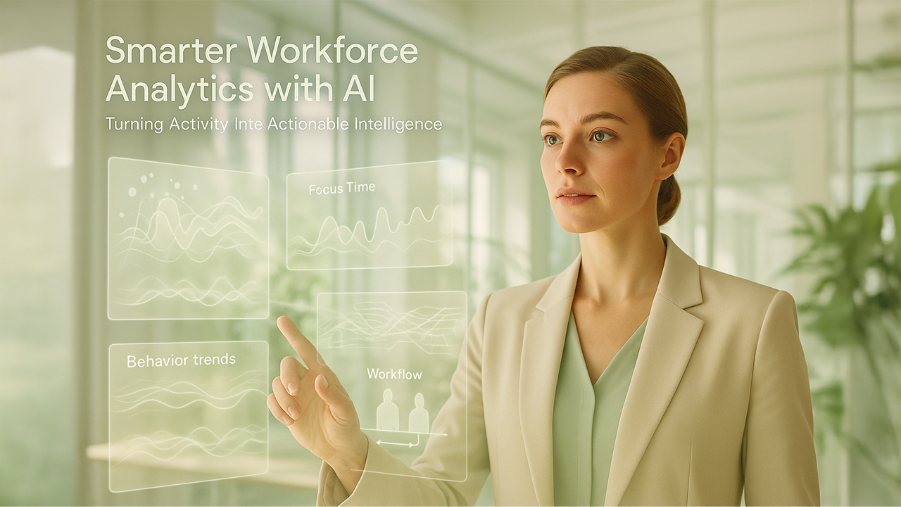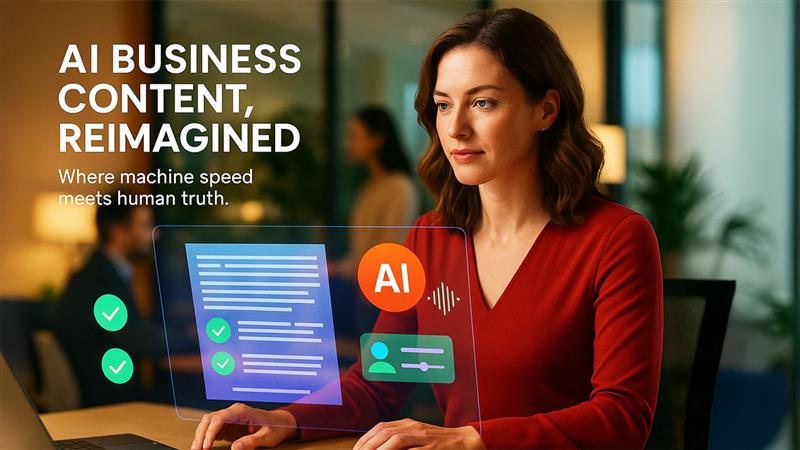Artificial Intelligence and automation have been extensively revolutionizing the modern workplace. Once limited to simple activity logs and screenshots, now employee monitoring software is evolving into a powerful platform for evaluating data that is qualified for providing meaningful insights about workforce behavior, performance, and well-being.
Artificial Intelligence and automation have been extensively revolutionizing the modern workplace. Once limited to simple activity logs and screenshots, now employee monitoring software is evolving into a powerful platform for evaluating data that is qualified for providing meaningful insights about workforce behavior, performance, and well-being.
AI does not just track – it interprets, forecasts and assists businesses in making informed decisions. This advancement marks the beginning of a new era of data centric workforce management, where surveilling is making a shift from oversight to intelligence.
This blog explores how AI and automation are transforming employee monitoring software, the benefits that they offer to organizations, and ways to execute them ethically and effectively.

1. From Tracking to Understanding: How AI Changes the Game

Traditional forms of employee monitoring were usually visible in the form of metrics like keystrokes, idle time, and application usage. These tools allow for tracking these surface level metrics while drawing little analysis on the performance of employees and no insightful analysis of the data. Today, AI now takes all these data points and applies machine learning to analyze patterns, determine anomalies, and predict future patterns.
For example, AI can:
- Recognize productivity restrictions in workflows before they are able to affect deadlines.
- Analyze the way collaboration tools assess communication efficiency.
- Based on behavioral shifts, it detects early signs of burnout or disengagement.
That's very helpful in shifting the context of monitoring from a reactive mode to proactively managing, where leaders can leverage real-time intelligent reports rather than standard static reports.
2. Automation: Turning Data into Actionable Insights

Data collection is not a challenge; understanding the data and taking meaningful action is where automation can be most useful. New modern employee monitoring software has automated analytical dashboards to help summarize relevant trends, analyze data, and even notify a manager of relevant concerns.
Automation can:
- Generate summaries based on weekly performance without requiring manual data entry.
- Flag unusual behaviors/activities (e.g., sudden drops in focus time or excessive overtime).
- Automate process suggestions for team workflows or well-being check-ins.
Through automated regular data analysis, managers can prioritize high level decision making regarding improving processes and workloads, rather than spending time reviewing reports. Automating everyday business operations like performance reporting and alert notifications frees leadership to focus on strategic initiatives rather than administrative overhead.
3. Predictive Analytics: The Future of Workforce Optimization

Monitoring technologies utilizing artificial intelligence (AI) formulates predictions about probabilities, such as an employee's level of performance, the chance of leaving, or the risk of burnout using predictive model opportunities.
For example, if the software observed an employee who works late night hours frequently, and who was also demonstrating declining engagement scores, that employee may be flagged as at risk of burnout. In a similar way, machine learning models are deployed to see which projects are more likely to be behind schedule through examining their historical activity patterns.
Predictive analytics benefits companies by allowing them to:
- Take proactive action before problems escalate.
- Improve retention by ensuring workloads are balanced.
- Forecast productivity peaks for better resource planning.
This proactive approach redefines monitoring as a wellness and efficiency tool rather than a disciplinary system.
4. Enhanced Objectivity and Fair Evaluation
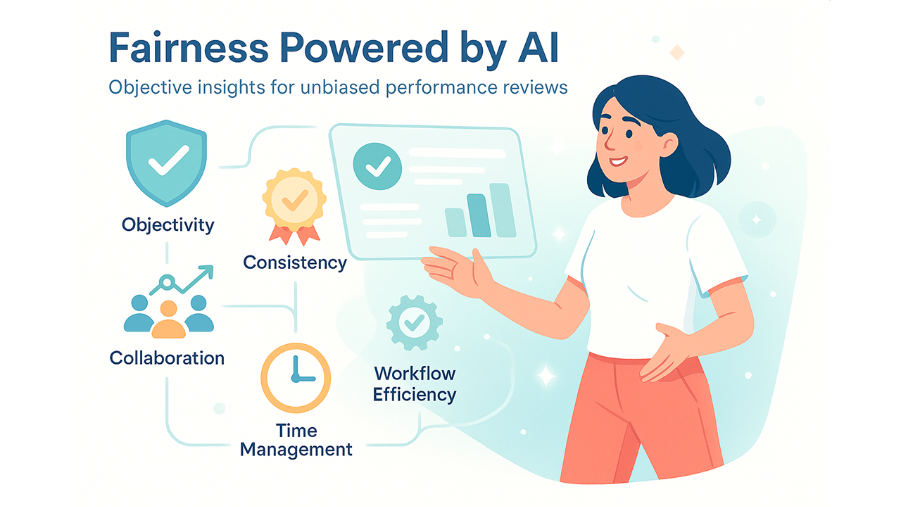
Human biases often impact evaluations of employees’ performances. AI-based employee monitoring helps eliminate bias by providing objective information and perspectives rather than subjective impressions.
Employee monitoring software can analyze:
- Output consistency and the employee's ability to focus.
- Collaboration and communication metrics
- Time management and workflow efficiency
This ensures that performance assessments are fair and transparent by creating an information-backed framework for evaluation based on data. It can help identify high performers who may fall through the cracks of evaluation.
If AI is used responsibly, it can level a playing field for employees to be evaluated on their measurable contributions rather than mere opinions or physical presence in the office.
5. Integration of Monitoring Data into HR and Business Systems
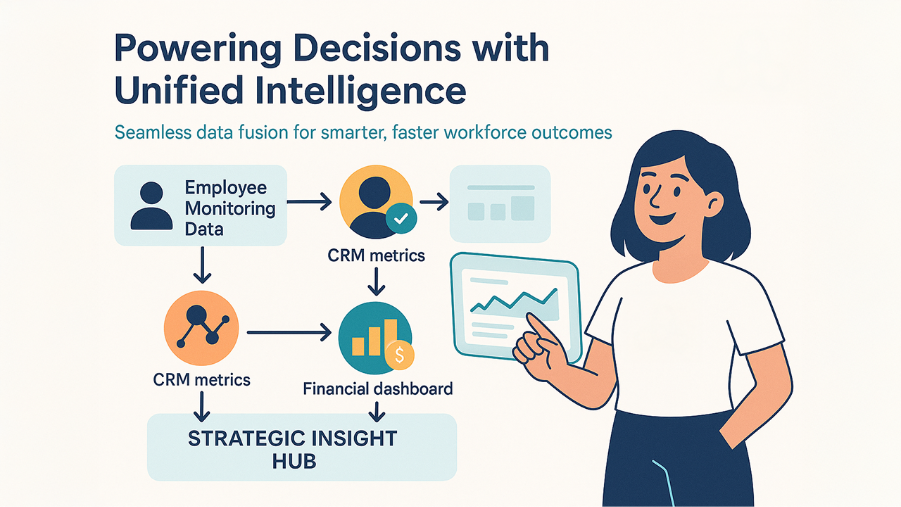
The next frontier of workforce analytics is integration. Software that monitors employees, when integrated with HR platforms, project management tools, and customer service systems, provides businesses with a 360-degree view of performance and business outcomes.
For example:
- Monitoring data combined with HR analytics can show how engagement affects retention.
- Integrations with CRM tools can show how employee activity influences customer satisfaction.
- Linking with financial dashboards helps estimate the productivity initiatives' ROI.
This unified data ecosystem turns monitoring into a strategic decision-making engine, where people analytics are aligned with business growth.
6. AI for Employee Wellness and Work-Life Balance

Perhaps the most promising application of AI in monitoring software concerns the protection of well-being for employees.
AI algorithms can detect subtle changes in behavior—from an uptick in out-of-hours activities, longer response times, or frequent changes of context—which can flag potential burnout or overload. Others can even recommend taking breaks or rebalancing the workload.
Rather than penalizing underperformance, AI prevents exhaustion, creates healthy work habits, and builds a culture of care and sustainability.
7. Ethical and Legal Considerations: Balancing Insight and Privacy

As AI and automation continue to enhance the power of monitoring software, businesses are treading carefully not to breach employee trust.
Ethical implementation includes:
- Being transparent about what data is collected and how it's used.
- Avoid invasive tracking, such as monitoring via webcam or personal device.
- Providing access to their data dashboards for employees.
- Comply with GDPR and other regulations relevant to privacy.
Organizations that can properly convey the benefits of AI-powered monitoring to workers and make it clear how it promotes their well-being are much more likely to maintain a positive, trust-based working environment.
8. AI-Powered Monitoring: Real-World Applications
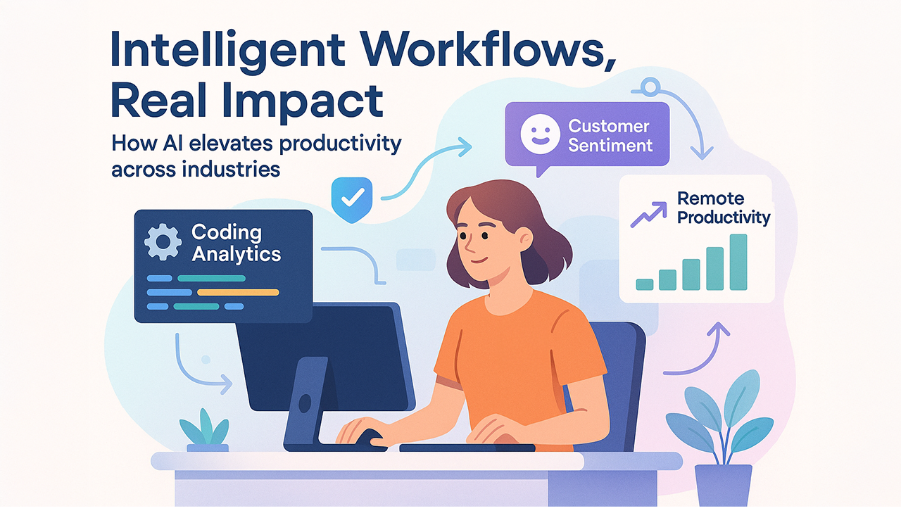
Companies across various verticals today use AI-based employee monitoring to optimize their workflows.
- IT & Tech organizations apply AI to the analysis of coding patterns in order to flag bottlenecks within their software development pipelines.
- Customer Support Teams monitor response times and sentiment analysis for the quality of the service.
- Automated focus time tracking lets remote work environments understand when teams tend to be most productive and schedule tasks in relation to that.
These use cases illustrate the point that AI-powered monitoring has to do with intelligent enablement, not control.
9. The Role of Transparency in AI-Driven Monitoring

Transparency is key to its implementation. It is important for the employees to know just what is being tracked and how AI perceives it.
Encourage open discussions about:
- What algorithms analyze and why?
- How are insights driving improvements within workflows of teams?
- What controls protect against data misuse?
The more the workers understand the system, the more they will treat it as an ally in mutual productivity and not as a surveillance threat.
10. Preparing for the Next Phase of Workforce Analytics

For employee monitoring software, the integration of AI and AI-driven automation is only the beginning. The future of systems will initiate the use of biometric data, emotional AI, and sentiment analysis to push farther on the dimensions of employee experience.
However, with expanded capabilities comes greater ethical responsibility. Companies that thoughtfully balance technological innovation with transparency, empathy, and respect for privacy will be the ones that win.
Conclusion
Employee monitoring software is no longer just about oversight; rather, it’s fast turning into one of the core pillars of workforce analytics and organizational intelligence. That promises a future in which, via AI and automation, companies can have more insight into productivity, engagement, and well-being while continuing to build trust-based cultures striving for continuous data-driven improvement.
That's where the future of work belongs to organizations that deploy AI not to monitor workers but to understand and then empower and uplift them.
Respond to this article with emojis



